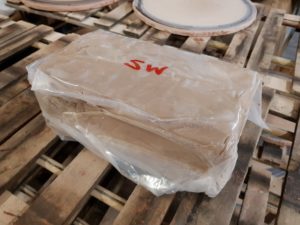Clay Manufacturing – Background
As a potter throwing terracotta flower pots and other garden products using a clay from Bristle Clay Tiles, I was becoming frustrated with the quality of the clay.
It was basically their tile clay softened down and extruded as a large block. It often had bits of rubbish and hard clay lumps along with the odd bit of metal from the machines, including nuts and bolts.
Eventually the manager got sick of my complaints and suggested that I get some basic machinery and set up my own little plant and they would supply me with the clay mix crushed to the hammermilled stage. So I did.
The clays I make are from blends derived in the main from raw materials found in Western Australia. I am using red clay from the Swan Valley, Toodyay schist and Wickepin Kaolin. By changing the proportions of these clays and sometimes the addition of feldspar, bentonite or grog added to enhance the performance of the product.
Types of Clay Currently Made
Fine Ironstone – Ballmilled blend that I use for throwing flower pots and other garden and building products.
Fired at 1100°C it is a terracotta colour. The clay will handle higher temperatures and changes colour through to a purplish dark red to almost a black if fired in reduction.
Normally the clay needs wedging before use and is a good throwing body for all shapes of pottery commonly made by throwing.
Firing temperatures:
Bisque 850°C
Terracotta 1100°C
Ironstone1250°C
Fine Dark Buff Stoneware – Ballmilled blend, which is milled for a longer time to give a finer clay than ironstone.
This clay was originally intended as a blend for wood firing where the iron in the body and ashes from the wood would combine to give interesting variations of surface finish and colour. It will also vitrify at normal stoneware temperatures so is suitable for household products that require that feature.
I find this body easy centering, takes shaping well and stands up while working, it also has a strong greenware strength which makes dry handling easier.
Firing Temperatures:
Bisque 850 – 950 °C
Gloss 1250 – 1280 °C
Fine Cream Clay – This body is the same clay blend as the Buff Stoneware but without the addition of body fluxing ingredients. At stoneware temperature firing this clay is still porous and so it shouldn’t be used where water tight products are required.
Intended for sculptural work where the old coarse cream clay was being used. A finer finish is achieved with this clay. I also use it for making some of my kiln furniture as it still throws well.
Firing temperatures:
Bisque 850 – 950°C
Gloss 1280°C – find the limit and let me know.
While I make the clays with the intent of throwability, most users have found them able to be used with other pottery forming techniques.
